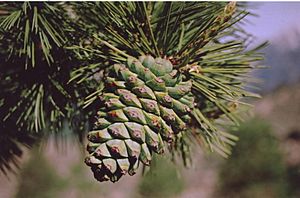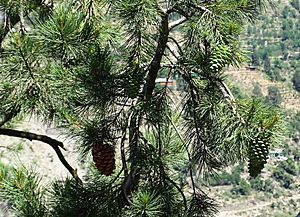Chilgoza pine facts for kids
Quick facts for kids pine nut |
|
|---|---|
 |
|
| Pinus gerardiana female cone | |
| Conservation status | |
| Scientific classification | |
| Genus: |
Pinus
|
| Species: |
gerardiana
|
The Chilgoza pine (scientific name: Pinus gerardiana) is a special type of pine tree. It's also called neja. This tree grows naturally in the northwestern Himalayas mountains. You can find it in countries like Afghanistan, Pakistan, and India. It likes to grow high up, between 1800 and 3350 meters above sea level.
Chilgoza pines often grow near other trees. These include the Cedrus deodara and Pinus wallichiana trees.
Contents
What Does the Chilgoza Pine Look Like?
Chilgoza pine trees usually grow to be 10 to 20 meters tall. Some can even reach 25 meters! They often have wide, open tops with long, straight branches. In thick forests, their tops might be narrower.
The tree's bark is very flaky. It peels off to show light grayish-green patches underneath. This is similar to the lacebark pine. The smaller branches are smooth and olive-green.
Leaves and Cones
The leaves of the Chilgoza pine are like needles. They grow in groups of three and are 6 to 10 centimeters long. They stick out stiffly and are shiny green on the outside. The inside has blue-green lines called stomatal lines.
The cones are quite large, about 10 to 18 centimeters long. When they open, they can be 9 to 11 centimeters wide. Inside these cones are the famous pine nuts.
Chilgoza Pine Nuts
The seeds, or pine nuts, are 17 to 23 millimeters long. They are 5 to 7 millimeters wide. They have a thin shell and a very small wing. These nuts are very popular for eating!
Why is the Chilgoza Pine Important?
The Chilgoza pine is known for its delicious and healthy pine nuts. These nuts are full of carbohydrates and proteins. They are called "chilgoza" or "neja" (singular) and "neje" (plural) by local people.
A Valuable Crop
Chilgoza nuts are a very important source of income. They help tribal people in places like the Kinnaur district. This area is in Himachal Pradesh, India. The nuts are quite expensive. They can sell for a lot of money per kilogram.
Protecting the Chilgoza Pine
This tree species is listed as "near threatened." This means it could be at risk if we don't protect it. Too much cutting of trees and animals eating young plants can stop new trees from growing.
Forest departments have tried to plant new Chilgoza pines. However, the young trees have not grown very well. It's important to find ways to help this special pine tree survive.
History of the Chilgoza Pine
The scientific name P. gerardiana honors Captain Patrick Gerard. He was a British army officer in India. The tree was first brought to England in 1839. It grows well in warmer, drier parts of southeast England. However, it is not planted very often there.
External links
See also
 In Spanish: Pinus gerardiana para niños
In Spanish: Pinus gerardiana para niños



